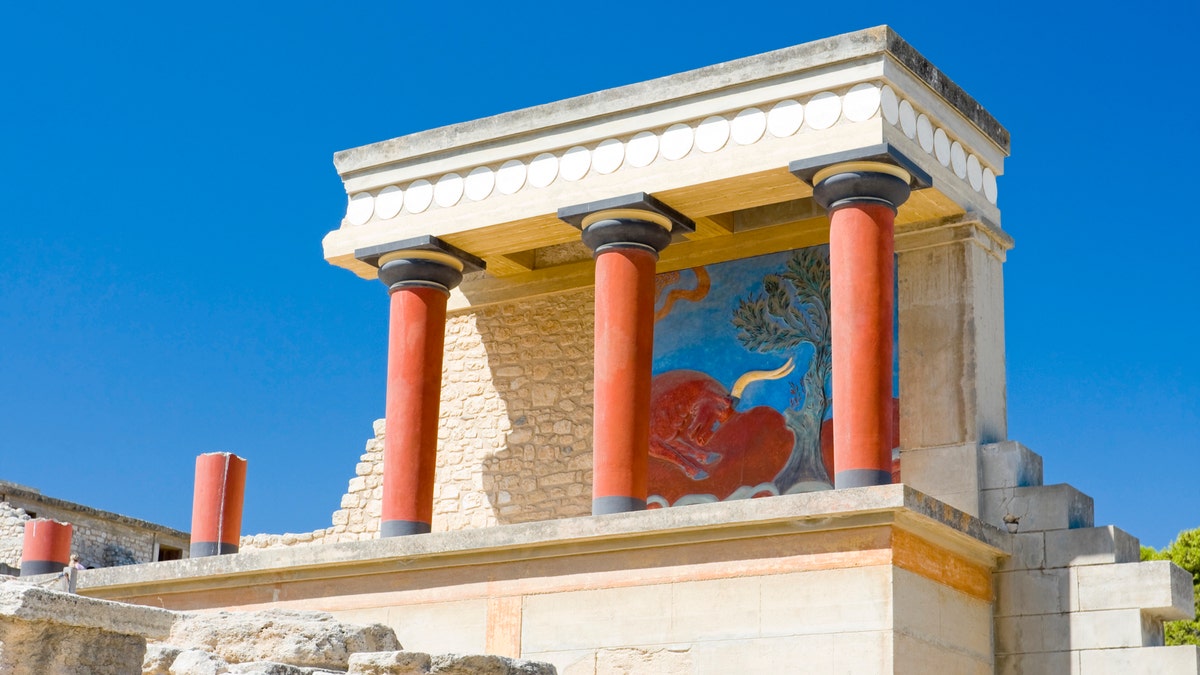
North gate at Knossos palace, Crete, Greece, iStock (LUke1138)
DNA research is shedding new light on the mysterious ancient Minoan civilization on the island of Crete and their counterparts on the Greek mainland, the Mycenaeans.
The civilizations were Europe’s first literate societies and were the cultural ancestors of later Classical Greece. The Minoan civilization existed from around 2600 to 1100 B.C. and the Mycenaeans existed from around 1700 to 1050 B.C.
The Minoans have long puzzled historians. The civilization created the first European writing system and built vast palace complexes with vibrant art, but seemed to spring up in isolation, experts said.
DNA DISCOVERY IDENTIFIES LIVING DESCENDANTS OF BIBLICAL CANAANITES
Clues as to their origins have proved hard to come by. While the ancient palace of Knossos on Crete offers some insight into their society, and the Minoans feature prominently in Greek mythology, their main script, known as Linear A, hasn’t been deciphered.
Now researchers from the Max Planck Institute for the Science of Human History and Harvard Medical School have drilled down into ancient DNA to find answers.
“There is this assortment of hard archaeology, linguistics, and legends that give us some idea about what was going on in Crete during the Minoan period, which has led to many theories about where the Minoans came from,” Dr. Iosif Lazaridis, postdoctoral fellow at Harvard Medical School and the study’s lead author, told Fox News via email. “But, no hard facts, because the language was unique and unknown and it's not clear who the relatives of the Minoans were outside Crete.”
EXPERTS HUNT FOR BIBLICAL TABERNACLE THAT HOUSED THE ARK OF THE COVENANT
Researchers analyzed genomic data from 19 individuals, including Minoans, Mycenaeans, a Neolithic individual from ancient Greece, and Bronze Age individuals from southwestern Anatolia, which is in modern day Turkey. By comparing the information generated with previously published data from nearly 3,000 other people, both ancient and modern, the researchers were able to work out the relationships between the groups.
The results show that the Minoans were genetically very similar to the Mycenaeans. Individuals in both civilizations shared more than 75 percent of their ancestry with farming people that lived in Greece and western Turkey thousands of years earlier during the Neolithic period.
“This is quite remarkable – it was genetic continuity with the first farmers of Europe – they settled the region about 4,000 years prior to the Minoan and Mycenaean cultures,” Dr. Alissa Mittnik, a researcher at the Max Planck Institute for the Science of Human History, told Fox News.
ARCHAEOLOGISTS UNEARTH 2,700-YEAR OLD RESERVOIR IN ISRAEL
“This is very surprising because the Mycenaeans were in many ways culturally different than the Minoans: their tombs and art are replete with weapons, they had horses, chariots, and were very hierarchical because they buried their chieftains with copious amounts of gold and built their ‘Cyclopean’ citadels with huge limestone blocks,” added Lazaridis. “The later Mycenaeans are usually identified with the Achaeans of Homer's ‘Iliad,’ who were the people that sacked Troy.”
Lazaridis explained that the remainder of the Minoans’ and Mycenaeans’ ancestry came from Armenia, Georgia and Iran. The latter civilization’s ancestry can also be traced back to Eastern Europe and Siberia, according to the researcher, who noted that modern Greeks are quite genetically similar to the Mycenaeans.
“We may be removing some of the mystique surrounding these people by showing that they weren't that different from the people that came before or after them,” Lazaridis told Fox News. “The Minoans and Mycenaeans didn't have any special ancestry: they were made of the same basic ‘stuff’ as other people from Europe and the Middle East. So we can't answer the question of why these civilizations flourished thousands of years ago, but we can at least cast some light on who they were and where they came from.”
The findings are published in the journal Nature.
Follow James Rogers on Twitter @jamesjrogers
